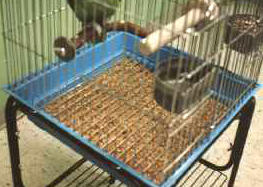
Is Cat Litter a Safe Cage Liner?
Lately we have heard more and more people telling us they use one of several different types of cat litter for the bottom of their Parrots’ cages. Here are the reasons why this is dangerous.
Cat litter may contain sodium bentonite clay which binds the litter when wet. Sodium bentonite expands to 15 times its dry size when wet. If your Parrot happens to forage for food on the bottom of his cage and ingests a little piece of clay, it can literally expand so much that it will not pass through the body and be eliminated. Also, if the dust from the clay coats your Parrot’s food, there is a potential for gastrointestinal problems. Overtime, the dust will build up on the walls of the intestine to the point of preventing the absorption of water or nutrients and thus starving your Parrot.
Most litters also contain silica dust. The dust swirls up when you put the litter into the box. It causes respiratory issues and is a known carcinogen inflicting a cancer called Silicosis in cats, dogs and humans. The silica dust is so small that it is practically invisible. When it gets into a human’s lung, the body has a negative reaction and proceeds to create vast amounts of scar tissue in the air sacs. The scar tissue restricts the lungs from stretching as much as needed, thus limiting the ability to breathe. The probability of silicosis is heightened for an animal in a confined space, such as their cage.
The other common types of litter such as corn based litter, newspaper pellet litter and sand litter also have risks.
What Parrot does not like corn? Corn cob litter while a great choice for cat litter, yes it is just 100% corn, is compressed and expands when wet. Unfortunately, just like the clay litter it will expand if ingested and can cause a blockage in the crop or intestines.
Newspaper pellet littler will also expand 4 to 6 times its original size. Using it in your Parrot's cage is like playing Russian roulette. Every time your Parrot goes down to the bottom of his cage to forage for treats or the food he just dropped, there is a chance that he will grab the paper-pellet litter and ingest it. With the amount of mucus in the crop, the moistened litter will expand and likely stay there, causing infections and a very large vet bill.
Sand litter has the potential to impact your Parrot’s crop. The tiny sharp granules, if ingested, get stuck in the muscle tissue and folds of the crop causing infection in your pet.
The safest choice is simply newsprint. Printed newsprint is perfectly safe as printers have been using vegetable based dyes for over 20 years.
As a point of interest Mammal's and Parrot's lungs are quite different. Mammal’s lungs are found on either side of the heart and have lobes whereas a Parrot’s lungs are a solid mass located against the bones of the back and are relatively non-expandable. Parrots do not have a diaphragm and cannot remove anything in their lungs by coughing. They breathe by expanding their ribcage outwards which draws air through the lungs to eight air sacs. The air sacs act as 'bellows' to ventilate the lungs. Compared to humans who use one breath to exchange the air in the lungs, it takes Parrots two breaths, one in and one out.
